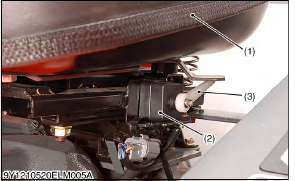Understanding Your Kubota’s Operator Presence System (OPS)
What is the Kubota Operator Presence System?
Core Safety Functions
The OPS performs several life-saving safety functions that have revolutionized tractor safety across the agricultural industry:
Engine Shutdown Protection – Completely shuts down the engine if you leave the seat while the tractor is moving or implements are engaged
PTO Disengagement – Automatically stops rotating implements when no operator presence is detected
Hydraulic System Lockout – Disables loader arms, three-point hitches, and hydraulic implements
Movement Prevention – Stops the tractor from moving by disabling transmission or applying parking brakes
How Your OPS Works
The Seat Switch Mechanism
– Operating weight threshold: 80-100 pounds
– Response time: Instantaneous engagement, 0.5-2 second delay for disengagement
– Electrical specs: 12V DC with low amperage switching
– Switch type: Normally open, closes when activated
The foundation of your OPS is the seat switch located directly beneath your operator seat. This spring-loaded mechanism responds to your weight and presence, closing a circuit that signals to the tractor’s control system when sufficient weight is applied. The switch is engineered to withstand thousands of activation cycles while maintaining precise calibration for consistent safety performance.
Integration with Tractor Systems
Modern Kubota tractors integrate the OPS with multiple vehicle systems through a centralized Electronic Control Module (ECM). This creates a comprehensive safety network connecting:
Engine management system
Transmission controls
PTO engagement mechanisms
Hydraulic control valves
Dashboard warning systems
The integration allows for intelligent decision-making based on operating conditions, providing graduated responses rather than simply shutting everything down immediately.
Common Problems and Symptoms
Starting Issues
Symptom: Tractor fails to crank or start despite proper key position and adequate battery power.
Root Causes:
Corroded or damaged seat switch contacts
Misaligned seat switch mounting brackets
Broken or loose wiring connections
Insufficient operator weight to activate switch
Switch calibration drift over time
Environmental factors such as moisture infiltration, temperature extremes, and vibration from normal operation can gradually degrade switch performance, leading to intermittent or complete failure.
PTO-Related Malfunctions
Symptom: Engine runs normally until you engage the PTO, then immediately shuts down. PTO won’t Engage?
Diagnostic Indicators:
Engine runs fine in neutral with PTO disengaged
Immediate shutdown upon PTO lever movement
Dashboard warning lights illuminate before shutdown
Normal restart after returning PTO lever to neutral
Movement and Hydraulic Problems
Symptom: Engine runs normally but tractor won’t move, hydraulics operate weakly or not at all.
This safety feature prevents runaway tractors but can be frustrating when caused by faulty sensors detecting false operator absence. Understanding the system logic helps diagnose whether the issue is mechanical, electrical, or calibration-related.
Testing and Diagnostic Procedures
Visual Inspection Protocol
✓ Switch housing for cracks or damage
✓ Actuator arm for proper movement and alignment
✓ Mounting brackets for looseness or damage
✓ Wiring connections for corrosion or looseness
✓ Seat cushion integrity affecting weight distribution
Electrical Testing Methods
Using a digital multimeter, test the seat switch for proper electrical function:
Testing Parameters:
Open circuit resistance: >1 MΩ (megohm)
Closed circuit resistance: <1 Ω (ohm)
Operating voltage: 12V DC nominal
Current draw: <0.5 amp during switching
⚠️ CRITICAL SAFETY WARNING
Adjustment and Replacement Procedures
Seat Switch Adjustment Techniques
Many OPS problems can be resolved through proper adjustment rather than component replacement:
1. Locate seat switch mounting bracket under seat pivot
2. Loosen mounting bolts slightly (don’t remove completely)
3. With operator seated, adjust bracket for firm switch contact
4. Verify consistent actuation through full seat range
5. Tighten bolts to specification (15-20 ft-lbs)
6. Test operation thoroughly
Switch Replacement Process
When replacement is necessary, use only genuine Kubota OPS switches or approved equivalents meeting original specifications.
Average Replacement Costs:
Seat switch replacement: $75-$150 (parts and labor)
Wiring harness repair: $125-$300
Complete system overhaul: $500-$1,200
Model-Specific Considerations
B-Series Tractors
Incorporate multiple interconnected safety switches including seat, PTO, rocker pedal, and transmission switches. All must be in proper positions for starting.
L-Series Tractors
Feature more sophisticated OPS with dual wiring runs for redundancy and enhanced hydraulic safety lockouts.
BX-Series Tractors
May require PTO lever sensitivity adjustments through tab bending for better engagement consistency.
Prevention and Maintenance Best Practices
Preventive Maintenance Schedule
Monthly: Visual inspection of connections and wiring
Quarterly: Electrical contact cleaning and tightening
Annually: Complete electrical system testing and documentation
As needed: Environmental protection improvements
Regular maintenance not only prevents costly failures but also ensures the system responds reliably in emergency situations where split-second activation could prevent serious injury or death.
Key Takeaways
The Kubota Operator Presence System is a critical safety technology that has significantly reduced tractor-related accidents. Understanding its function, recognizing common problems, and maintaining it properly ensures both safety and operational efficiency. Never permanently disable safety systems – the protection they provide far outweighs any temporary inconvenience.
Frequently Asked Questions
Why won’t my Kubota tractor start even though the battery is good?
The most common cause is a faulty or misadjusted seat switch in the Operator Presence System. The OPS prevents starting if it doesn’t detect proper operator presence. Check that you’re fully seated and the seat switch is making proper contact.
Can I bypass the OPS if it’s malfunctioning?
Only qualified technicians should perform temporary diagnostic bypassing for troubleshooting purposes. Never permanently disable the OPS as it’s a critical safety system designed to prevent serious accidents and fatalities.
How often should I maintain my OPS system?
Perform visual inspections monthly, clean electrical contacts quarterly, and have complete system testing done annually. This preventive maintenance typically costs $100-200 per year but prevents expensive emergency repairs.
What’s the average cost to repair a faulty OPS?
Basic seat switch replacement costs $75-150, while more complex wiring repairs range from $125-300. Complete system overhauls can cost $500-1,200, but this is rare with proper maintenance.
Check us out for more expert tractor maintenance guides at TractorPartsCentral.com

